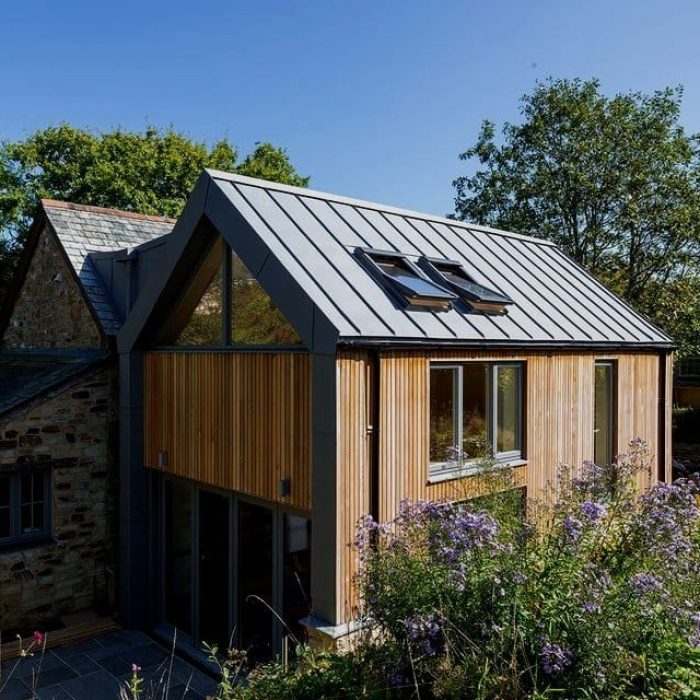Timber Cladding




Premium British timber cladding
At The Larch Cladding Company, we are your trusted source for premium timber cladding options in Wales and across the UK. Whether you’re looking to transform a modern home, renovate a traditional property, or design a standout commercial build, we supply high-quality exterior timber cladding solutions to suit your project.
Our carefully selected range of cladding timber includes popular species such as Larch Cladding, Cedar Cladding, and Douglas Fir Cladding, each offering unique benefits in terms of durability, appearance, and sustainability. All of our timber cladding exterior products are sourced from responsibly managed forests and supplied uncoated, giving you the freedom to finish them according to your design needs.
We are proud to supply FSC® certified timber (FSC-C134890), ensuring that every piece of external timber cladding we offer meets rigorous environmental and ethical standards.
We provide external timber cladding suitable for vertical and horizontal applications, making it ideal for everything from residential façades to large-scale architectural developments. Whether you’re after a clean, contemporary finish or a more natural, rustic look, our exterior cladding timber combines long-lasting performance with stunning visual appeal.
If you’re considering vertical timber cladding or need custom sizes for a bespoke project, we also offer a full cutting and profiling service. Explore our wide range of timber wall cladding profiles to find the perfect fit for your design.
– British timber sourced in Wales
– From FSC (FSC-C134890) managed forests
– Supplied uncoated
Explore Our Range of Timber Cladding Profiles
At The Larch Cladding Company, we offer a wide selection of timber cladding profiles to suit a variety of styles, applications, and architectural preferences. Whether you’re working on a traditional barn conversion or a contemporary new build, the right profile can transform the overall appearance and performance of your project.
All of our cladding timber profiles are crafted using high-quality British timber and are suitable for both vertical timber cladding and horizontal applications. Each profile has its own aesthetic and functional advantages, helping you achieve the look you want while ensuring long-term durability.
Our most popular timber wall cladding profiles include:
- Shiplap Cladding – A classic overlapping profile that creates a smooth, uniform finish. Shiplap is ideal for both traditional and modern designs and offers excellent weather resistance.
- Tongue and Groove Cladding – Designed to interlock seamlessly, this profile provides a tight, clean finish and is often used for residential and commercial projects where a sleek look is desired.
- Shadow Gap Cladding – A contemporary option that creates sharp, linear shadow lines between each board for a refined, architectural finish.
- Feather Edge Cladding – Perfect for rustic and rural properties, feather edge boards taper to create a stepped appearance, offering excellent water runoff and a heritage feel.
- Square Edge Cladding – With its straight, planed edges, this clean-cut profile suits modern builds and can be installed vertically or horizontally for a sharp, uniform look.
- Rainscreen Profile – A modern, ventilated cladding system that improves airflow behind the boards and enhances the overall durability of your exterior timber cladding.
- Waney Edge Cladding – Retaining the natural edge of the timber, this profile adds character and charm, making it perfect for more organic or countryside projects.
No matter your design intent, our wide choice of profiles ensures you’ll find the perfect external timber cladding solution. All profiles are available in Larch, Cedar, or Douglas Fir, and we also offer a bespoke cutting service to match your precise project specifications.
Explore our full range of profiles on our Timber Cladding Profile page to discover the best match for your build.
Timber cladding provides a natural and durable option for enhancing the exterior of buildings. The following guide outlines the steps for installing timber cladding, ensuring both an aesthetically pleasing and long-lasting finish. Whether you’re working with larch, cedar, or another type of timber, these steps can guide you through the installation process.
Tools and Materials Needed:
- Timber cladding boards: Choose based on the desired appearance and properties.
- Stainless steel nails or screws: To avoid corrosion and ensure longevity.
- Hammer or screwdriver: Depending on your choice of fasteners.
- Saw: For cutting the timber to the necessary lengths.
- Spirit level: To guarantee a straight and level installation.
- Breathable waterproof membrane: Essential in some installations to protect against moisture.
- Battens: For creating a ventilation gap behind the cladding.
Preparation Steps:
- Measure Your Space: Determine how much cladding you’ll need by measuring the area you plan to cover.
- Choose Your Timber: Select the grade and profile of timber cladding according to your project’s aesthetic and functional requirements.
- Prepare the Wall: Ensure the wall surface is clean, dry, and smooth. Install horizontal battens if you’re cladding over insulation or an uneven surface to provide a level framework.
Installation Process:
- Install a Breathable Waterproof Membrane: If required, apply this over the wall or insulation, starting at the bottom and overlapping each sheet by at least 150mm as you move upwards.
- Fix Horizontal Battens: Space the battens according to your cladding profile. Ensure they are level and allow for proper ventilation at both the top and bottom of the wall.
- Begin Cladding at the Bottom Corner: Use the spirit level to place the first board horizontally. This ensures the rest of your cladding aligns correctly.
- Attach the Cladding Boards: Secure them to the battens with stainless steel nails or screws, leaving a small expansion gap (around 2mm) between the boards.
- Overlap or Join Boards: Follow your chosen style (e.g., ship-lap, tongue and groove), staggering joints across the wall for better strength and visual appeal.
- Work Upwards: Maintain level alignment for each board as you progress. Trim boards as necessary to fit around obstacles like windows or corners.
- Finish the Cladding: Depending on the timber type, you might want to apply a protective oil. Some timbers can be left to weather naturally, while others may require a protective oil to maintain their look.
We’re proud to supply premium-quality trade timber to professionals throughout the UK’s construction and design industries. Whether you’re an architect, contractor, engineer, estimator, or quantity surveyor, our sustainably sourced, precision-cut timber is crafted to meet the demands of today’s building and joinery projects.
Timber Cladding Range

Larch Cladding
Larch cladding is renowned for its natural resistance to decay and unique ageing process, as it transforms into a charming silver-grey patina over time. This type of cladding is versatile, making it ideal for various architectural styles.

Cedar Cladding
Cedar cladding is known for Its natural resistance to decay, insects, and moisture making it a popular choice for high-end residential properties, resorts, and commercial buildings, where both aesthetics and durability are paramount.

douglas fir cladding
Douglas fir cladding, with its reddish-brown to pale yellow hues, offers strength and stability. Ideal for modern designs, its dense grain ensures durability and structural integrity, making it suitable for residential and commercial projects.
Why Choose Timber Cladding?
Timeless Beauty
Timber cladding adds warmth and character to any building, with its natural grains and tones providing a timeless and elegant look.
Sustainability
Timber is a renewable resource, making timber cladding an eco-friendly choice when sourced responsibly.
Durability
High-quality timber cladding, when properly maintained, can last for decades, ensuring a long-lasting investment in your property.
Insulation
Timber has excellent insulating properties, helping regulate indoor temperature and reduce energy consumption.
Versatility
Timber cladding is incredibly versatile, and suitable for a wide range of architectural styles, from traditional to contemporary designs.
Natural Weathering
Timber cladding develops a beautifully weathered patina, offering a low-maintenance way to achieve a naturally aged appearance.
Timber Cladding FAQ
Timber cladding, also known as wood cladding, involves covering the exterior of a building with wood panels or planks to protect it against the elements and to provide aesthetic appeal. It’s a popular choice for its natural beauty, versatility, and sustainability. Timber cladding can come in various types, including hardwoods and softwoods, each with unique properties and appearances suitable for different climates and design preferences.
The durability of timber cladding can vary depending on the type of wood used, the quality of installation, and the climate. Hardwoods generally offer more durability than softwoods. To ensure longevity, timber cladding requires regular maintenance, including:
- Protection: Applying a finish or sealant to protect against moisture, UV rays, and insects.
- Cleaning: Gently cleaning the surface to remove dirt, algae, or moss can prevent decay.
- Inspection: Regularly inspecting for signs of damage or wear and addressing issues promptly can extend the cladding’s life.
Choosing the right type of wood and adhering to proper maintenance practices can make timber cladding a long-lasting and beautiful choice for any building.
Choosing the right timber for cladding involves considering several factors:
- Climate: Select a wood species that is suited to your local climate. Some woods are better for wet climates, while others are suited for dry conditions.
- Aesthetic Preference: Consider the colour, grain, and texture of the wood. These characteristics will significantly impact the building’s appearance.
- Durability: Look for woods that are naturally resistant to rot, decay, and insect infestation. Hardwoods generally offer more durability than softwoods but may come at a higher cost.
- Sustainability: Opt for timber sourced from sustainably managed forests to ensure your cladding choice is environmentally responsible.
- Maintenance Level: Some types of wood require more maintenance than others to retain their appearance and durability. Consider how much time and effort you are willing to invest in upkeep.
Consulting with our professional team who can help you make an informed decision based on your specific needs and preferences, ensuring that your timber cladding serves both functional and aesthetic purposes effectively.
For our Profile ranges, we supply premium timber options including Larch Cladding, Cedar Cladding, and Douglas Fir Cladding. Each of these timbers is carefully selected for its durability, natural beauty, and suitability for various architectural and cladding applications. Whether you’re looking for the distinctive qualities of Larch Cladding, the rich tones of Cedar Cladding, or the strength of Douglas Fir Cladding, our range is designed to meet the highest standards for your project.
Yes, timber cladding is an excellent choice for exterior use. It’s designed to withstand the elements while providing natural insulation and a beautiful finish. Our exterior timber cladding options are selected for their durability, weather resistance, and aesthetic versatility. Whether you’re installing timber wall cladding on a new build or upgrading an older property, our timber cladding exterior products are ideal for both residential and commercial applications.
Absolutely. Vertical timber cladding is a growing trend in both modern and traditional architecture. It creates the illusion of height, adds a clean and contemporary look to façades, and promotes efficient water runoff. All of our external timber cladding profiles, including shiplap, tongue and groove, and square edge, can be installed vertically or horizontally, depending on your design preference.
Yes, we proudly supply FSC® (FSC-C134890) certified timber, including our full range of exterior cladding timber. This means our timber comes from responsibly managed forests that meet the highest environmental and social standards. Choosing FSC-certified timber wall cladding not only ensures quality and traceability but also supports sustainable building practices.




